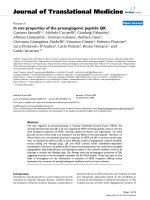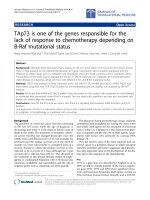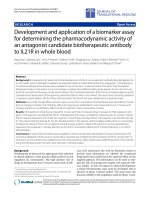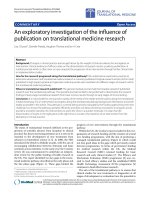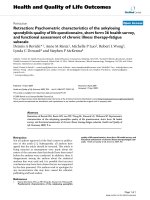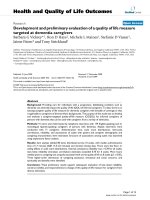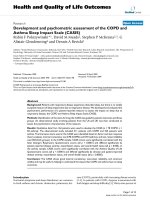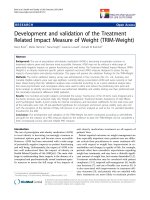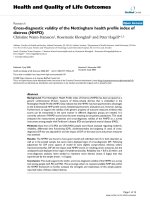Báo cáo hóa học: " Development and validation of a Greek language version of the Manchester Foot Pain and Disability Index" docx
Bạn đang xem bản rút gọn của tài liệu. Xem và tải ngay bản đầy đủ của tài liệu tại đây (300.51 KB, 9 trang )
BioMed Central
Page 1 of 9
(page number not for citation purposes)
Health and Quality of Life Outcomes
Open Access
Research
Development and validation of a Greek language version of the
Manchester Foot Pain and Disability Index
Patricia Kaoulla
1
, Nicoletta Frescos
1
and Hylton B Menz*
2
Address:
1
Department of Podiatry, Faculty of Health Sciences, La Trobe University, Bundoora, Victoria 3086, Australia and
2
Musculoskeletal
Research Centre, Faculty of Health Sciences, La Trobe University, Bundoora, Victoria 3086, Australia
Email: Patricia Kaoulla - ; Nicoletta Frescos - ; Hylton B Menz* -
* Corresponding author
Abstract
Background: The Manchester Foot Pain and Disability Index (MFPDI) is a 19 item questionnaire
used to assess the severity and impact of foot pain. The aim of this study was to develop a Greek-
language version of the MFPDI and to assess the instrument's psychometric properties.
Methods: The MFPDI was translated into Greek by three bilingual content experts and two
bilingual language experts, and then back-translated into English to assess for equivalence. The final
Greek version was administered, along with a questionnaire consisting medical history and the
Medical Outcomes Study Short Form 36 (SF-36), to 104 Greek-speaking, community-dwelling
people (64 female, 40 male), aged between 64 and 90 years (mean 73.00, SD 5.26) with disabling
foot pain.
Results: The Greek translation of the MFPDI was found to have high internal consistency
(Cronbach's α= 0.89, and item-total correlation coefficients from 0.33 to 0.72). Principal
components analysis revealed a four-factor structure representing the constructs of functional
limitation, pain intensity, concern with appearance and activity restriction, which explained 60.8%
of the variance, with 38.9% of the variance explained by the first construct (functional limitation).
Six items demonstrated different factor loadings to the original English version.
Conclusion: The Greek-language version of the MFPDI appears to be a valid tool in assessing foot
pain in Greek-speaking older people. The total MFPDI scores are comparable between the Greek
and English version, however due to differences in the factor loadings of some items, between-
language comparisons of MFPDI should be undertaken with some caution.
Background
It has long been recognised that foot pain is common in
older people and has a significant detrimental impact on
mobility and quality of life. Community-based studies
indicate that between 20 and 30% of community-dwell-
ing people aged 65 years or over report foot pain [1-4].
Older people with foot pain demonstrate impaired bal-
ance and gait [3,5], report greater difficulty in performing
activities of daily living [6], and have reduced health-
related quality of life [7] compared to those without foot
pain.
Several instruments have been developed to quantify the
severity and impact of foot pain, including the American
Published: 1 June 2008
Health and Quality of Life Outcomes 2008, 6:39 doi:10.1186/1477-7525-6-39
Received: 15 February 2008
Accepted: 1 June 2008
This article is available from: />© 2008 Kaoulla et al; licensee BioMed Central Ltd.
This is an Open Access article distributed under the terms of the Creative Commons Attribution License ( />),
which permits unrestricted use, distribution, and reproduction in any medium, provided the original work is properly cited.
Health and Quality of Life Outcomes 2008, 6:39 />Page 2 of 9
(page number not for citation purposes)
Orthopaedic Foot and Ankle Society scales [8], the Foot
Function Index [9] and the Foot Health Status Question-
naire [10]. However, only one instrument – the Manches-
ter Foot Pain and Disability Index (MFPDI) – has been
validated in both middle-aged and older populations
[11,12]. The MFPDI consists of 19 statements beginning
with the phrase "Because of pain in my feet", which were
initially found to cluster around three constructs: func-
tional limitation (10 items), pain intensity (5 items) and
concern with personal appearance (2 items) [11]. The
remaining two items are related to the difficulty in per-
forming work or leisure activities, which are excluded
from the questionnaire if the respondent is of retirement
age. A recent validation study in older people reported
similar findings; however an additional fourth construct –
activity restriction – was identified [12]. Since the initial
development of the MFPDI, it has been applied in a pop-
ulation-based survey of foot pain [13] as an outcome
measure in a clinical trial [14] and as a measure of foot
pain in people with Ehlers-Danlos syndrome [15] and
early rheumatoid arthritis [16].
The MFPDI appears to be a useful tool for the assessment
of disabling foot pain in older people. However, the
MFPDI has not been translated into other languages other
than Swedish [15], thereby limiting the instrument's
research potential. This is a particular problem in coun-
tries with large, ageing migrant populations, such as Aus-
tralia, as many older migrants may not be sufficiently
proficient in the English language to enable valid ques-
tionnaire data to be collected without the aid of a transla-
tor. Therefore, the aim of this study was to develop a
Greek-language version of the MFPDI and to evaluate its
internal consistency and construct validity.
Methods
Translation process
Three Greek-speaking content experts (two podiatrists
and one foot and ankle surgeon) and two Greek-speaking
linguistic experts independently translated the MFPDI
into Greek. Three of the bilingual experts then evaluated
the Greek versions, and any discrepancies were discussed
and rectified by consensus. A professional Greek transla-
tor, who had no knowledge of the English questionnaire,
independently back-translated the combined Greek lan-
guage questionnaire into English. Three content experts,
two Greek-speaking and the other non-Greek speaking,
then compared the original English version to the back-
translated questionnaire (see Figure 1).
Translation processFigure 1
Translation process.
Content expert
#1
Content expert
#2
Content expert
#3
Language expert #1
(professional translator)
Language expert #1
(Hellenic studies scholar)
5 versions compared by content experts
#1 and 2, and language expert #2
Discrepancies addressed by
consensus
Greek version back-translated into
English by language expert #1
Back-translated E nglish version
compared to original English version
Translation into Greek
Health and Quality of Life Outcomes 2008, 6:39 />Page 3 of 9
(page number not for citation purposes)
Participants
Participants in this study (n = 104) were recruited from
four metropolitan elderly Greek citizen social groups in
Melbourne, Australia. In order to recruit participants, a 10
minute presentation on foot disorders was delivered to
each group. Included in the presentation was a brief out-
line of the study and a call for volunteers with foot pain to
participate. The participants were required to be mobile
and capable of walking household distances unaided, in
order to evaluate the effect that foot pain has on routine
mobility tasks. The study was approved by the Faculty of
Health Sciences Human Ethics Committee of La Trobe
University (application number: FHEC07/73) and
informed consent was obtained from all participants.
Medical history questionnaire and demographic
information
A questionnaire relating to the participants' age, medical
history and foot pain location was interviewer adminis-
tered. The medical history section of the questionnaire
required the participant to state whether they had any of
the 15 common conditions listed. Participants who
reported foot pain were asked to indicate the location of
the pain on eight diagrams of the feet. The participants
then completed the Greek language version of the MFPDI.
A total score for the MFPDI was obtained according to the
following scoring system for each of the 17 items: none of
the time (score = 0), some days (score = 1), on most days/
everyday (score = 2). General health-related quality of life
was assessed with the validated Greek language version of
the Medical Outcomes Study Short Form-36 (SF-36) [17].
Foot assessment
Several clinical observations of foot structure were docu-
mented. Arch height was assessed by measuring the height
of the navicular tuberosity in millimetres while the subject
was fully weightbearing. This score was corrected for dif-
ferences in foot size by dividing it by the length of the foot
[18]. Ankle flexibility was measured in degrees using a
modified version of the weightbearing lunge test. The lat-
eral malleolus and head of the fibula was first located and
marked with an ink pen. Participants then stood with
their right foot placed alongside a vertically-aligned clear
acrylic plate inscribed with 2° protractor markings, and
were instructed to take a comfortable step forward with
the left leg. In this position, participants were instructed to
bend their knees to squat down as low as possible, with-
out lifting the right heel from the ground and while keep-
ing the trunk upright. The position of the fibular head was
marked on the clear acrylic plate, and the angle formed
between the lateral malleolus and the fibular head was
measured. The test was completed three times, and the
average score documented as the test result [19]. The pres-
ence and severity of hallux valgus ("bunions") was deter-
mined using the Manchester scale [20]. This instrument
consists of standardised photographs of feet with four
degrees of hallux valgus – none (score = 0), mild (score =
1), moderate (score = 2) and severe (score = 3) which were
matched to the subject's feet. Gradings obtained using this
scale are strongly associated with angular deformity meas-
urements obtained from foot x-rays [21]. Presence of
lesser digital deformity (hammertoes and clawtoes), corns
and calluses were determined according to previously
published criteria [22]. The reliability of these measure-
ments performed on older people has been established
previously [19].
Statistical analysis
All statistical tests were conducted using SPSS Release 14
for Windows (SPSS Inc, Chicago, IL, USA). In order to
determine the suitability of the data for principal compo-
nents analysis, the Kaiser-Meyer-Olkin Measure of Sam-
pling Adequacy (KMO) and Bartlett's Test of Sphericity
were calculated. The KMO was found to be 0.84, which
exceeds the recommended minimum value of 0.60 [23].
The Bartlett's Test of Sphericity was highly significant (χ
2
= 764, p < 0.001), supporting the suitability of the data for
principal components analysis [24]. Internal consistency
was determined using Cronbach's alpha and item-total
correlation coefficients. A principal components analysis
was then performed to determine whether the 17 items in
the questionnaire could be combined into separate com-
ponents reflecting different aspects of foot pain and disa-
bility. A four component solution was extracted using the
Kaiser-Guttman rule (eigenvalues > 1.0), and varimax
rotation was performed to minimize the complexity of
loadings for each component. Correlations between the
total MFPDI score with the SF-36 subscales were deter-
mined using the Pearson's r correlation coefficient.
Results
Translational issues
Differences between the original English version and the
back-translated version of the Manchester Foot Pain and
Disability Index can be seen in Table 1. Six of the seven-
teen items used in this study were back translated identi-
cally to the original questionnaire. There were difficulties
in translating two of the seventeen items: "My feet are
more painful in the evening" (item 16) and "I get shoot-
ing pains in my feet" (item 17). The final Greek version is
shown in Figure 2.
Characteristics of sample
The characteristics of the sample, including sex, preva-
lence of major medical conditions and medication use is
shown in Table 2. The average age of the participants was
73 years (SD 5.3). The most common medical conditions
amongst the participants included heart problems
(61.5%), peripheral vascular disease (57.7%) and oste-
Health and Quality of Life Outcomes 2008, 6:39 />Page 4 of 9
(page number not for citation purposes)
oarthritis (76.9%). More than forty per cent of the partic-
ipants (41.3%) were taking four or more medications.
Internal consistency
The Cronbach's α calculation for the 17 items of the
MFPDI was 0.89, indicating a high degree of internal con-
sistency. The item-total correlation coefficients were gen-
erally between 0.45 and 0.72, with two exceptions: item
13 (0.37) and item 16 (0.33).
Floor and ceiling effects
Frequencies of participants' responses to individual items
of the MFPDI are shown in Table 3. All items exhibited a
good spread of responses across the three categories, with
no item demonstrating clear floor or ceiling effects. The
items with the highest proportion of "on most days/every
day" responses were "I avoid standing for a long time"
(56%) and "I avoid walking distances" (46%), whereas
the items with the lowest proportion were "I feel self-con-
scious about my feet" (10%) and "I get self-conscious
about the shoes I have to wear" (6%).
Principal components analysis
Results of the principal components analysis are shown in
Table 4, along with the factor structure reported in the
original validation study of English-speaking older people
[12]. A four-factor model was extracted which accounted
for 61% of the total variance. However, the majority of the
variance was explained by the first component (38.9%).
Component 1 represented 13 items pertaining to func-
tional limitation (items 1–7, 9–12, 14, 17), component 2
represented two items pertaining to pain intensity (items
15 and 16), component 3 represented one item pertaining
to concern about appearance (item 13), and component 4
represented one item pertaining to activity restriction
(item 8, which also loaded onto component 1).
Correlates of total MFPDI score
Women had a higher total MFPDI score than men (15.64
vs. 11.63; t = -2.46, df = 102, p = 0.01). The total MFPDI
score was significantly associated with each of the sub-
scales of the SF-36: physical (r = -0.66, p < 0.001), role-
physical (r = -0.56, p < 0.001), bodily pain (r = -0.66, p <
0.001), general health (r = -0.56, p < 0.001), vitality (r = -
0.68, p < 0.001), social function (r = -0.53, p < 0.001),
role-emotional (r = -0.49, p < 0.001) and mental health (r
= -0.53, p < 0.001). There were no significant associations
between any of the foot assessment variables and MFPDI
scores.
Discussion
This study was undertaken to develop a Greek-language
version of the Manchester Foot Pain and Disability Index
and to assess its psychometric properties. Compared to
other languages, Greek does not have any significant vari-
ations in the use of words, however some regional differ-
ences exist. The Greek questionnaire developed in this
study used "standard" Greek and avoided colloquialisms
in order to allow all Greek-speaking people to understand
it. This was important in avoiding differences in the psy-
chometric properties of the questionnaire.
Table 1: Original MFPDI questions compared to the back translated MFPDI questions.
Original MFPDI questions Back-translated MFPDI questions
I avoid walking outside at all I totally avoid walking outside
I avoid walking long distances I avoid walking long distances*
I don't walk in a normal way I don't walk in a normal way*
I walk slowly I walk slowly*
I have to stop and rest my feet I need to stop and rest my feet
I avoid hard or rough surfaces when possible I avoid walking on hard or uneven surfaces
I avoid standing for a long time I avoid standing for long periods
I catch the bus or use the car more often I take the bus or use the car more often
I need help with housework/shopping I require help with jobs around the home/with shopping
I still do everything but with more pain or discomfort I still do everything but with more pain or discomfort *
I get irritable when my feet hurt I become irritable when my feet ache
I feel self-conscious about my feet I am embarrassed of my feet
I get self-conscious about the shoes I have to wear I am embarrassed of the shoes I have to wear
I have constant pain in my feet I have constant pain in my feet*
My feet are worse in the morning My feet are worse in the morning*
My feet are more painful in the evening My feet are more painful at night
I get shooting pains in my feet I have stabbing pains in my feet
I am unable to carry out my previous work I am unable to cope with my previous job†
I no longer do all my previous activities (sport, dancing, hill-walking, etc) I no longer do my former activities (sport, dancing, hiking etc)†
NB: * word-perfect back-translation, † Questions excluded from this study, as participants were of retirement age
Health and Quality of Life Outcomes 2008, 6:39 />Page 5 of 9
(page number not for citation purposes)
Greek language version of the Manchester Foot Pain and Disability IndexFigure 2
Greek language version of the Manchester Foot Pain and Disability Index.
–
ȆĮȡĮțȐIJȦ ȣʌȐȡȤȠȣȞ μİȡȚțȑȢ ʌĮȡĮIJȘȡȒıİȚȢ ȖȚĮ ʌȡȠȕȜȒμĮIJĮ ʌȠȣ ʌĮȡȠȣıȚȐȗȠȞIJĮȚ ıIJȠȣȢ ĮȞșȡȫʌȠȣȢ ȜȩȖȦ ʌȩȞȠȣ
ıIJĮ ʌȩįȚĮ IJȠȣȢ
īȚĮ țȐșİ ʌĮȡĮIJȒȡȘıȘ ıȘμİȚȫıIJİ ĮȞ ĮȣIJȠ ıĮȢ ȑȤİȚ ıȣμȕİȓ IJȠȞ ʌİȡĮıμȑȞȠ μȒȞĮ ǹȞ ȞĮȚ ıȣȞȑȕİȚ μȩȞȠ μİȡȚțȑȢ
μȑȡİȢ IJȚȢ ʌİȡȚııȩIJİȡİȢ Ȓ țȐșİ μȑȡĮ IJȠȣ ʌİȡĮıμȑȞȠȣ μȒȞĮ
ȈĮȢ ʌĮȡĮțĮȜȫ ȞĮ ıȘμİȚȫıIJĮȚ ıİ ȑȞĮ țȠȣIJȓ ȖȚĮ țȐșİ ʌȡȠIJȐıȘ
ȆȠIJȑ ȂİȡȚțȑȢ
μȑȡİȢ
ȉȚȢ ʌİȡȚııȩIJİȡİȢ
ȀȐșİ μȑȡĮ
ȟĮȚIJȓĮȢ IJȠȣ ʌȩȞȠȣ ıIJĮ ʌȩįȚĮ μȠȣ
ǹʌȠijİȪȖȦ ȞĮ ʌİȡʌĮIJȫ ȑȟȦ İȞIJİȜȫȢ
ǹʌȠijİȪȖȦ ȞĮ ʌİȡʌĮIJȫ μĮțȡȚȞȑȢ ĮʌȠıIJȐıİȚȢ
ǻİȞ ʌİȡʌĮIJȫ μİ țĮȞȠȞȚțȩ IJȡȩʌȠ
ȆİȡʌĮIJȫ ıȚȖĮȞȐ
ȆȡȑʌİȚ ȞĮ ıIJĮμĮIJȒıȦ țĮȚ ȞĮ ȟİțȠȣȡȐıȦ IJĮ ʌȩįȚĮ μȠȣ
ǹʌȠijİȪȖȦ ȞĮ ʌİȡʌĮIJȫ ıİ ıțȜȘȡȑȢ Ȓ ĮȞȫμĮȜİȢ İʌȚijȐȞİȚİȢ
ǼȟĮȚIJȓĮȢ IJȠȣ ʌȩȞȠȣ ıIJĮ ʌȩįȚĮ μȠȣ
ǹʌȠijİȪȖȦ ȞĮ ıIJȑțȠμĮȚ ȖȚĮ ʌȠȜȣ ȫȡĮ
ȆĮȓȡȞȦ IJȠ ȜİȦijȠȡİȓȠ Ȓ ȤȡȘıȚμȠʌȠȚȫ IJȠ ĮȣIJȠțȓȞȘIJȠ ʌȚȠ ıȣȤȞȐ
ȋȡİȚȐȗȠμĮȚ ȕȠȒșİȚĮ μİ IJȚȢ įȠȣȜİȚȑȢ IJȠȣ ıʌȚIJȚȠȪ μİ IJĮ ȥȫȞȚĮ
ǹțȩμĮ țȐȞȦ IJĮ ʌȐȞIJĮ ĮȜȜȐ μİ ʌİȡȚııȩIJİȡȠ ʌȩȞȠ Ȓ İȞȠȤȜȒıİȚȢ
īȓȞȠμĮȚ ȞİȣȡȚțȩȢ ȩIJĮȞ ʌȠȞȐȞİ IJĮ ʌȩįȚĮ μȠȣ
ȃIJȡȑʌȠμĮȚ ȖȚĮ IJĮ ʌȩįȚĮ μȠȣ
ȃIJȡȑʌȠμĮȚ ȖȚĮ IJĮ ʌĮʌȠȪIJıȚĮ ʌȠȣ ʌȡȑʌİȚ ȞĮ ijȠȡȫ
DzȤȦ ıȣȞȑȤİȚĮ ʌȩȞȠ ıIJĮ ʌȩįȚĮ μȠȣ
ȉĮ ʌȩįȚĮ μȠȣ İȓȞĮȚ ȤİȚȡȩIJİȡĮ IJȠ ʌȡȦȓ
ȉĮ ʌȩįȚĮ μȠȣ ʌȠȞȠȪȞ ʌİȡȚııȩIJİȡȠ IJȠ ȕȡȐįȣ
Ȃİ ıȠȣȕȜȓȗȠȣȞ IJĮ ʌȩįȚĮ μȠȣ
ǼȟĮȚIJȓĮȢ IJȠȣ ʌȩȞȠȣ ıIJĮ ʌȩįȚĮ μȠȣ
ȓ
ǹįȪȞĮIJZ ȞĮ IJĮ ȕȖȐȜȦ ʌȑȡĮ IJȘȞ ʌȡȠȘȖȠȪμİȞȘ
įȠȣȜİȚȐ μȠȣ
ǻİȞ țȐȞȦ ʌȚĮ IJȚȢ ʌȡȠȘȖȠȪμİȞİȢ įȡĮıIJȘȡȚȩIJȘIJȑȢ μȠȣ ĮșȜȒμĮIJĮ
ȤȠȡȩ SHUSȐWKPD ıİ ȜȩijȠȣȢ țIJȜ
ȈȘμİȚȫıIJİ İįȫ ȩIJĮȞ ȑȤİIJİ įȚĮȕȐıİȚ ȩȜİȢ IJȚȢ ʌȡȠIJȐıİȚȢ ıİ ĮȣIJȒ IJȘ ıİȜȓįĮ
Health and Quality of Life Outcomes 2008, 6:39 />Page 6 of 9
(page number not for citation purposes)
The translation process was relatively straightforward. Six
of the seventeen items (items 2, 3, 4, 10, 14, and 15) were
back-translated identically to the original questionnaire.
The remaining nine items (item 1, 5, 6, 7, 8, 9, 11, 12, 13)
were very similarly back translated to the original ques-
tionnaire. However, there were two significant transla-
tional issues. Firstly, item 16, "My feet are more painful in
the evening" was back-translated into "My feet are more
painful at night"; however the Greek word for "night"
(νχτα) is different from the word used for "evening"
(βράδυ). To be consistent with the original MFPDI,
"evening" was retained. The most difficult translational
issue was with item 17, "I get shooting pains in my feet".
The Greek word for "shooting" (τουφεκισμζ) is a literal
translation for the act of shooting a gun; however, this
word is clearly not appropriate for describing pain. After
lengthy discussions regarding this item, an alternative
word meaning "piercing" (σουβλίζουν) was decided on
by the three bilingual content experts. This item was back-
translated to "I have stabbing pains in my feet". Although
there was difficulty in translating item 17, most of the par-
ticipants (60.6%) claimed that they experienced this disa-
bility on some (34.6%) or most/every day (26%), thus
suggesting that it was understood as a descriptor of pain
in this population.
The psychometric properties of the Greek MFPDI were
similar to the original English validation studies in mid-
dle-aged [11] and older participants [12]. Internal consist-
ency reported in our study was the same as that reported
by Menz et al. [12] but slightly lower than that reported by
Garrow et al. [11] in the initial validation study (Cron-
bach's α = 0.89 compared to 0.99). A Cronbach's α of 0.89
may be more desirable, as it is well above the acceptable
limit of 0.70 [25]. A very high Cronbach's α, such as that
reported by Garrow et al. [11] may indicate some degree
of redundancy in the MFPDI when assessing foot pain in
middle-aged people.
Similar to the initial validation study [11], the principal
components analysis revealed a four-component solu-
tion, strongly reflecting the three constructs of functional
limitation, pain intensity and concern with personal
appearance. These results differ from the study that vali-
dated the MFPDI in English-speaking older people that
found an additional construct relating to activity restric-
tion, describing a more severe impairment than func-
tional limitation [12]. In the current study we only found
a weak loading for this fourth construct. Furthermore,
item 8 ("I catch the bus or use the car more often") exhib-
ited some degree of cross-loading, in that two reasonably
high component coefficients (>0.5) were split across two
components (1 and 4). However, this is not unique to the
Greek version, as the original MFPDI exhibited cross-load-
ing on several items [11]. Although some authors have
suggested that cross-loading items should be deleted [26],
we decided to retain this item in order for the instrument
to be as similar as possible to the original MFPDI.
Similar to the original validation study, the two items "I
avoid walking outside at all" and "I need help with house-
work/shopping" were found to relate to functional limita-
tion, which differs to the finding of Menz et al. [12] who
reported these disabilities to be associated with a distinct
fourth construct – activity restriction. This indicates that
older Greek-speaking people may perceive these items as
less severe symptoms than English-speaking older people,
i.e.: they consider these statements as having a reduced
ability to perform the tasks, not an inability to complete
them.
Table 2: Sample characteristics.
Age (years) – mean (SD) 73.0 (5.3)
Sex – n (%)
Female 64 (61.5)
Male 40 (38.5)
Country of birth – n (%)
Greece 59 (56.7)
Cyprus 41 (39.4)
Egypt 2 (1.9)
Armenia 1 (1.0)
Australia 1 (1.0)
Education: total years – median (range) 5.5 (0 – 17)
Major medical conditions – n (%)
Heart problems 64 (61.5)
Peripheral vascular disease 60 (57.7)
Osteoarthritis 80 (76.9)
Hips 57 (54.8)
Hands/wrists 41 (39.4)
Spine 39 (37.5)
Knees 24 (23.1)
Feet 9 (8.7)
Cancer 24 (23.1)
Stroke 10 (9.6)
Diabetes 5 (4.8)
Rheumatoid arthritis 5 (4.8)
More than four medications – n (%) 43 (41.3)
Podiatry-related issues – n (%)
Currently receives podiatry 13 (12.5)
Previous foot surgery 6 (5.8)
Difficulty finding comfortable shoes 39 (37.5)
Needs more help looking after feet 42 (40.4)
Foot characteristics
Moderate to severe hallux valgus – n (%) 18 (17.0)
Calluses 29 (28.8)
Ankle flexibility (°) 40.1 (12.2)
Navicular height/foot length (mm) 0.11 (0.03)
Health and Quality of Life Outcomes 2008, 6:39 />Page 7 of 9
(page number not for citation purposes)
Another difference in the factor loading between this
study and that of Menz et al. [12] was that item 11 ("I get
irritable when my feet hurt") was located in the functional
limitation component. As with Garrow et al. [11], our
results suggest that Greek older people seem to relate to
this item as the frustration associated to the impaired
functional ability due to foot pain, rather than as a meas-
ure of the sensory experience of pain. Based on the differ-
ent constructs revealed by principal components analysis,
comparison of the subscales may not be possible when
comparing the results of the Greek language version
MFPDI to the original English version, however further
study in a more representative sample would be necessary
to confirm this. Nevertheless, comparison of the total
Table 3: Frequencies of responses to individual items on the Greek MFPDI. Data shown as n (%).
Item None of the time On some days On most days/every day
1. I avoid walking outside at all 69 (66) 20 (19) 15 (14)
2. I avoid walking distances 32 (31) 24 (23) 48 (46)
3. I don't walk in a normal way 52 (50) 29 (28) 23 (22)
4. I walk slowly 36 (35) 30 (29) 38 (36)
5. I have to stop and rest my feet 44 (42) 21 (20) 39 (38)
6. I avoid hard or rough surfaces where possible 35 (34) 29 (28) 40 (39)
7. I avoid standing for a long time 22 (21) 24 (23) 58 (56)
8. I catch the bus or use the car more often 24 (23) 46 (44) 34 (33)
9. I need help with housework/shopping 65 (63) 23 (22) 16 (15)
10. I still do everything but with more pain or discomfort 25 (24) 39 (38) 40 (39)
11. I get irritable when my feet hurt 40 (39) 42 (40) 22 (21)
12. I feel self-conscious about my feet 74 (71) 20 (19) 10 (10)
13. I get self-conscious about the shoes I have to wear 92 (89) 6 (6) 6 (6)
14. I have constant pain in feet 36 (35) 35 (34) 33 (32)
15. My feet are worse in the morning 61 (59) 14 (14) 29 (28)
16. My feet are more painful in the evening 53 (51) 30 (29) 21 (20)
17. I get shooting pains in my feet 41 (39) 36 (35) 27 (26)
Table 4: Component coefficients of the individual items of the MFPDI in older people and comparison to factor structure of Menz et al
[12].
Component 1 Component 2 Component 3 Component 4 Factor structure
% variance explained 38.9 8.2 7.1 6.6 Menz et al [12]. Current study
Item
1. I avoid walking outside at all 0.592 0.136 -0.423 0.386 AR FL*
2. I avoid walking distances 0.702 -0.029 -0.429 -0.042 FL FL
3. I don't walk in a normal way 0.703 -0.122 0.147 0.121 FL FL
4. I walk slowly 0.603 -0.473 -0.150 0.051 FL FL
5. I have to stop and rest my feet 0.773 -0.182 0.072 -0.061 FL FL
6. I avoid hard or rough surfaces where
possible
0.641 -0.084 -0.283 -0.283 FL FL
7. I avoid standing for a long time 0.636 -0.289 -0.063 0.116 FL FL
8. I catch the bus or use the car more often 0.539 0.218 -0.151 0.527 FL FL/AR*
9. I need help with housework/shopping 0.644 -0.145 0.077 -0.206 AR FL
10. I still do everything but with more pain or
discomfort
0.707 0.033 0.013 -0.377 PI FL*
11. I get irritable when my feet hurt 0.650 0.303 -0.044 0.025 PI FL*
12. I feel self-conscious about my feet 0.551 0.278 0.470 -0.263 CA FL*
13. I get self-conscious about the shoes I have
to wear
0.420 0.101 0.599 0.470 CA CA
14. I have constant pain in feet 0.768 0.178 0.134 -0.113 PI FL*
15. My feet are worse in the morning 0.483 0.601 0.285 0.161 PI PI
16. My feet are more painful in the evening 0.392 0.522 -0.078 0.107 PI PI
17. I get shooting pains in my feet 0.643 0.309 0.055 -0.226 PI FL*
Notes: FL – functional limitation, PI – pain intensity, CA – concern about appearance, AR – activity restriction. Factor loadings > 0.45 highlighted in
bold. *Different factor loading
Health and Quality of Life Outcomes 2008, 6:39 />Page 8 of 9
(page number not for citation purposes)
scores may be a useful measure in determining and com-
paring the severity of disabling foot pain in Greek and
English-speaking older people.
Construct validity was evidenced by significant correla-
tions between the Greek language MFPDI with all the sub-
scales of the previously validated Greek language version
of the SF-36 questionnaire [17]. The MFPDI and SF-36
purport to measure foot-specific and generic health-
related quality of life, respectively, so it was expected that
older people who scored poorly on one scale would also
score poorly on the other. However, there is a possibility
that these high correlations partly reflect some degree of
misinterpretation on behalf of the participants when
completing the MFPDI. As with the English version, the
Greek translation has the prefix "Because of pain in my
feet " before each of the items, however previous appli-
cations of the English version by Garrow et al. [11] and
Menz and Morris [19] have noted that some participants
respond to the MFPDI questions from the perspective of
their general health, and need to be reminded that the
questions pertain specifically to their feet.
Concurrent validity of the translated scale was evidenced
by significant differences in the total MFPDI scores of
male and female participants. This is consistent with pre-
vious observations that women are more likely to report
foot pain [3,4,27], due to an increased prevalence of hal-
lux valgus, corns and calluses [1,2,28], the wearing of ill-
fitting footwear [29], and sex differences in pain tolerance
levels [30].
One limitation of this study is that due to time con-
straints, the participants were conveniently recruited from
Greek elderly citizen groups. As such, they were all inde-
pendent community dwelling older people, capable of
walking household distances. The participants all
reported some degree of foot pain, however many of them
had never received foot care. It is therefore unclear as to
whether the findings may be generalisable to people out-
side this group, such as less mobile older people with
more severe pathologies requiring treatment from foot
care specialists.
Conclusion
The findings of this study indicate that the Greek language
version of the Manchester Foot Pain and Disability Index
is a useful tool in assessing the severity of disabling foot
pain in Greek-speaking older people, although the com-
ponent structure in our sample differs from the validation
of the instrument in English-speaking older people.
Increased use of this instrument in both epidemiological
studies and clinical trials will further develop our under-
standing of foot pain in the Greek-speaking population.
Abbreviations
MFPDI: Manchester Foot Pain and Disability Index; SF-
36: Medical Outcomes Study Short Form 36.
Competing interests
The authors declare that they have no competing interests.
Authors' contributions
NF and HBM conceived the study design, HBM conducted
the statistical analysis, PK collected the data, and all
authors interpreted the results, drafted the manuscript,
and read and approved the final manuscript.
Acknowledgements
A/Prof Menz is currently NHMRC Australian Clinical Research Fellow (id:
234424). We would like thank Kalliroy Katsigiannis (Centre for Hellenic
Studies, La Trobe University) and Dr Thanos Bedekas, MD (Orthopaedic
Foot and Ankle Surgeon, Athens, Greece) for their assistance with the
Greek translations.
References
1. Black JR, Hale WE: Prevalence of foot complaints in the elderly.
J Am Podiatr Med Assoc 1987, 77(6):308-311.
2. Dunn JE, Link CL, Felson DT, Crincoli MG, Keysor JJ, McKinlay JB:
Prevalence of foot and ankle conditions in a multiethnic
community sample of older adults. Am J Epidemiol 2004,
159:491-498.
3. Benvenuti F, Ferrucci L, Guralnik JM, Gangemi S, Baroni A: Foot pain
and disability in older persons: an epidemiologic survey. J Am
Geriatr Soc 1995, 43:479-484.
4. Gorter KJ, Kuyvenhoven MM, deMelker RA: Nontraumatic foot
complaints in older people. A population-based survey of
risk factors, mobility, and well-being. J Am Podiatr Med Assoc
2000, 90:397-402.
5. Menz HB, Lord SR: Foot pain impairs balance and functional
ability in community-dwelling older people. J Am Podiatr Med
Assoc 2001, 91:222-229.
6. Bowling A, Grundy E: Activities of daily living: changes in func-
tional ability in three samples of elderly and very elderly peo-
ple. Age Ageing 1997, 26:107-114.
7. Chen J, Devine A, Dick IM, Dhaliwal SS, Prince RL: Prevalence of
lower extremity pain and its association with functionality
and quality of life in elderly women in Australia. J Rheumatol
2003, 30:2689-2693.
8. Kitaoka HB, Alexander IJ, Adelaar RS, Nunley JA, Myerson MS, Sand-
ers M: Clinical rating systems for the ankle-hindfoot, midfoot,
hallux, and lesser toes. Foot Ankle Int 1994, 15:349-353.
9. Budiman-Mak E, Conrad K, Roach K: The Foot Function Index: a
measure of foot pain and disability. J Clin Epidemiol 1991,
44:561-570.
10. Bennett PJ, Patterson C, Wearing S, Baglioni T: Development and
validation of a questionnaire designed to measure foot-
health status. J Am Podiatr Med Assoc 1998, 88:419-428.
11. Garrow AP, Papageorgiou AC, Silman AJ, Thomas E, Jayson MIV, Mac-
farlane GJ:
Development and validation of a questionnaire to
assess disabling foot pain. Pain 2000, 85:107-113.
12. Menz HB, Tiedemann A, Kwan MMS, Plumb K, Lord SR: Foot pain
in community-dwelling older people: an evaluation of the
Manchester Foot Pain and Disability Index. Rheumatology 2006,
45:863-867.
13. Garrow AP, Silman AJ, Macfarlane GJ: The Cheshire Foot Pain
and Disability Survey: a population survey assessing preva-
lence and associations. Pain 2004, 110:378-384.
14. Waxman R, Woodburn H, Powell M, Woodburn J, Blackburn S, Hel-
liwell P: FOOTSTEP: a randomized controlled trial investi-
gating the clinical and cost effectiveness of a patient self-
management program for basic foot care in the elderly. J Clin
Epidemiol 2003, 56:1092-1099.
Publish with BioMed Central and every
scientist can read your work free of charge
"BioMed Central will be the most significant development for
disseminating the results of biomedical research in our lifetime."
Sir Paul Nurse, Cancer Research UK
Your research papers will be:
available free of charge to the entire biomedical community
peer reviewed and published immediately upon acceptance
cited in PubMed and archived on PubMed Central
yours — you keep the copyright
Submit your manuscript here:
/>BioMedcentral
Health and Quality of Life Outcomes 2008, 6:39 />Page 9 of 9
(page number not for citation purposes)
15. Berglund B, Nordstrom G, Hagberg C, Mattiasson AC: Foot pain
and disability in individuals with Ehlers-Danlos syndrome
(EDS): impact on daily life activities. Disabil Rehabil 2005,
27:164-169.
16. Lohkamp M, Burrow G, McCarron T, Granat M: The prevalence of
disabling foot pain in patients with early rheumatoid arthri-
tis. Foot 2006, 16:201-207.
17. Pappa E, Kontodimopoulos N, Niakas D: Validating and norming
of the Greek SF-36 Health Survey. Qual Life Res 2005,
14:1433-1438.
18. Menz HB, Munteanu SE: Validity of 3 clinical techniques for the
measurement of static foot posture in older people. J Orthop
Sports Phys Ther 2005, 35:479-486.
19. Menz HB, Tiedemann A, Kwan MMS, Latt MD, Lord SR: Reliability
of clinical tests of foot and ankle characteristics in older peo-
ple. J Am Podiatr Med Assoc 2003, 93:380-387.
20. Garrow AP, Papageorgiou A, Silman AJ, Thomas E, Jayson MI, Macfar-
lane GJ: The grading of hallux valgus. The Manchester Scale.
J Am Podiatr Med Assoc 2001, 91:74-78.
21. Menz HB, Munteanu SE: Radiographic validation of the Man-
chester scale for the classification of hallux valgus deformity.
Rheumatology 2005, 44:1061-1066.
22. Menz HB, Lord SR: The contribution of foot problems to
mobility impairment and falls in older people. J Am Geriatr Soc
2001, 49:1651-1656.
23. Kaiser H: An index of factorial simplicity. Psychometrika 1974,
39:31-36.
24. Bartlett MS: A note on the multiplying factors for various chi
square approximations. J Royal Stat Soc 1954, 16B:296-298.
25. Cronbach LJ: Coefficient alpha and the internal structure of
tests. Psychometrika 1951, 16:297-334.
26. Tabachnick BG, Fidell LS: Using multivariate statistics. 5th edi-
tion. Boston , Allyn and Bacon; 2006.
27. Menz HB, Morris ME: Determinants of disabling foot pain in
retirement village residents. J Am Podiatr Med Assoc 2005,
95:573-579.
28. Greenberg L: Foot care data from two recent nationwide sur-
veys. A comparative analysis. J Am Podiatr Med Assoc 1994,
84:365-370.
29. Menz HB, Morris ME: Footwear characteristics and foot prob-
lems in older people. Gerontology 2005, 51:346-351.
30. Thomas E, Peat G, Harris L, Wilkie R, Croft PR: The prevalence of
pain and pain interference in a general population of older
adults: cross-sectional findings from the North Staffordshire
Osteoarthritis Project (NorStOP). Pain 2004, 110:361-368.
